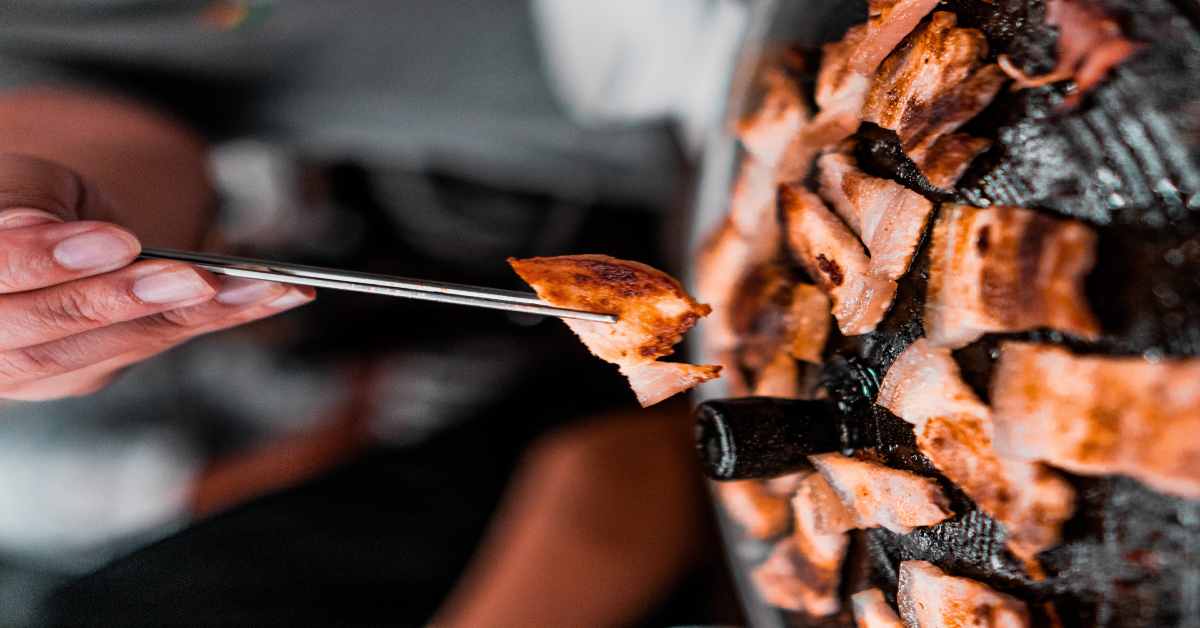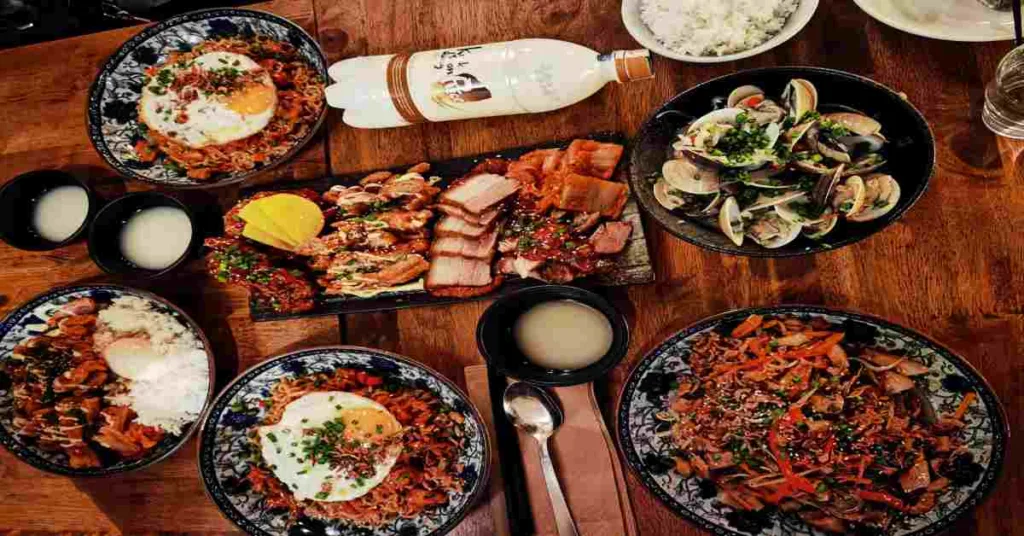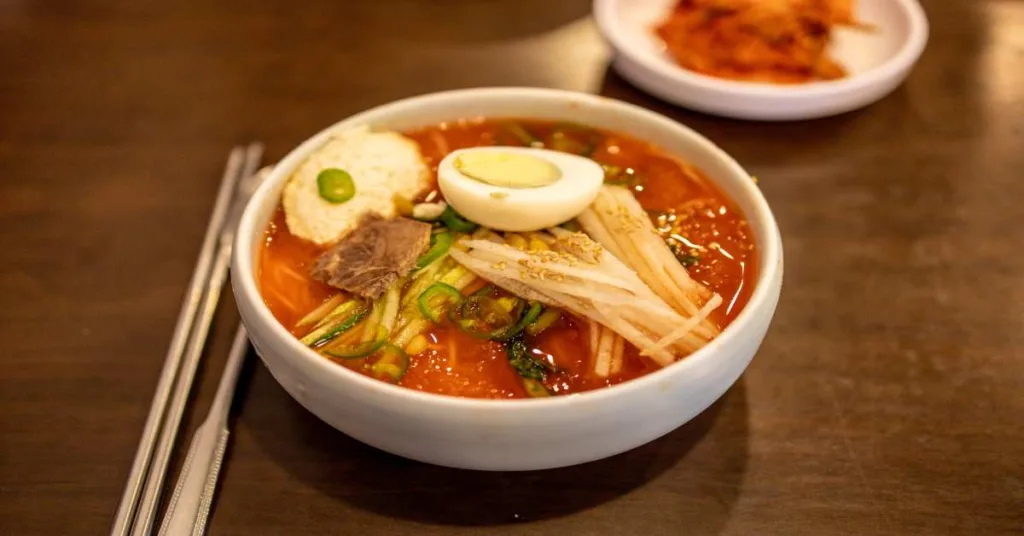It is a well-liked Korean dish. If you enjoy hog meat but are not a vegetarian, you should give Samgyeopsal a try. Thick slices of marinated hog belly pork that have been grilled right there on your table make up the entire meal. The strips are wrapped in lettuce, dipped in a sesame oil-based seasoning, and accompanied by a strip of onion and a strip of garlic.
Contents:
- What is Samgyeopsal?
- Benefits of Samgyeopsal
- Taste of Samgyeopsal
- Recipe
- What to serve with Samgyeopsal?
- How to eat Samgyeopsal?
What is Samgyeopsal?
Another typical Korean meal, Samgyeopsal, cooks chunky slices of pork belly on a grill right at the table and requires just rudimentary cooking abilities. It is then wrapped in lettuce or sesame leaves with dipping sauce.
Samgyeopsal, one of the most well-liked Korean cuisines in South Korea, is made up of grilled slices of unseasoned, marinated pork belly flesh. Samgyeop-sal, which translates to “three-layer flesh,” describes the lean and fat striations that, when cut, appear as three layers in the pork belly. Pork belly is also known as “Korean soul cuisine,” as eating Samgyeopsal and drinking Soju (Korean liquor) with friends gives Koreans comfort.
This meat dish was initially mentioned in a Donga-Ilbo article titled “How to Distinguish Between Good and Bad Meat” on November 3, 1984. In this article, the dish is referred to as “Segyepsal” rather than “Samgyeopsal.” Samgyeopsal appeared in the Standard Korean Language Dictionary after 1994.
When utilizing pork in traditional Korean dishes like Bossam or jeyuk-bokkeum, strong seasonings like ginger, garlic, and leek were utilized to mask the meat’s odour. The popularisation of Samgyeopsal was made possible once the smell issue was resolved using scientific techniques including castrating pork at the production level. In 1996, a Samgyeopsal known as “deep Samgyeopsal” was introduced. The name “daepae” means “plane” in Korean. There was created as a tool for cutting wood.
Beoljip Samgyeopsal, so named because the way the meat is chopped resembles a beehive (Beoljip in Korean), first appeared in the 2000s. Samgyeopsal culture was influenced by the Jeju island culture, which began serving larger servings of meat in Geun (a traditional Korean unit equal to 600gs) rather than 100gs, starting in 2005.
The most popular cut of pork among Koreans is pork belly. They are frequently grilled with pieces of garlic, onions, and kimchi before being dipped in a seasoning composed of salt and pepper blended with sesame seed oil. It is one of the most often served meals in Korean restaurants all around the world.
There are many good reasons to like Korean barbecued pork belly. It is soothing after a long day at work, healthful when consumed in moderation, and intriguing enough to be shared with others. To enjoy this dish, you don’t need to travel to a Korean restaurant.
Samgyeopsal is a favourite among foreign visitors and was rated as the top Korean meal they want to eat once they get home.
Benefits of Samgyeopsal
- It is rich in protein, vitamins, and minerals.
- It is also an excellent source of zinc, niacin, vitamin B6, vitamin B12, and protein.
- As a result of its high protein and low-fat content, it is typically served with high-fibre vegetables like lettuce and kimchi.
Taste of Samgyeopsal
The flavour of Samgyeopsal is more akin to that of a meaty, savoury cutlet or roast than bacon. Pork belly, however, is fairly bland before it is marinated and cooked. The flavour profile of the grilled pork belly is completely enhanced by the application of a dipping sauce. Therefore, we strongly advise creating one that meets your preferences. You can use a spicy Samgyeopsal recipe for the dipping sauce if you want it to be hotter, or you can make it sweet like a honey sauce.
Recipe
Ingredients: Pork, oil, garlic, ginger, gochujang, salt, pepper, soy sauce, rice vinegar, veggies.
For Samgyeopsal sauce: Doenjang (Korean soybean paste), onion, clove, gochujang, sugar, sesame seeds, and sesame oil.
Step 1: Marinate the pork
Pork belly is the highlight of Samgyeopsal. Choosing the best pieces of pork belly is so crucial. Pick a slice of pork belly that is slime-free, juicy without being greasy, and that appears clean.
- In a big bowl, combine soy sauce, rice vinegar, Gochujang sauce, sesame oil, ginger, and garlic powder. Add salt and pepper to taste next.
- Before grilling, thoroughly cover the pork belly with the marinade and let it sit in the refrigerator for two to 48 hours.
- At least two hours of marinating the meat will assist the fibres to retain moisture and keep the meat wet while it is being grilled.
Step 2: Slice various vegetables, and onions, to grill with the Samgyeopsal. Additionally, make some ripe cabbage kimchi and grill it alongside the pork belly; it’s delish!
Set up a barbecue on a table. Serve over rice, kimchi, sesame oil, and a salt mixture.
TIPS:
- Roll each slice of pork belly with a bay leaf in the middle for a prettier presentation. The marinade is then added.
- Use red wine for flavours with more complexity. If you prefer a pork belly that has a simpler flavour, use white wine.
- Don’t marinate the Korean pork belly for an excessive amount of time. By dissolving the protein molecules in the meat, a marinade makes the meat softer.
What to serve with Samgyeopsal?
Young professionals in Seoul love to pair their favourite dish, Samgyeopsal, with one or two shots of soju.
It also goes well with cooked rice, stews like kimchi-jjigae and doenjang-jjigae, and naengmyeon (cold noodles).
- Include some Ssam veggies and Ssamjang while serving!
- Include excellent side dishes like; Radish salad, cucumber salad, lettuce salad, and Jangahjji pickles are all sweet, tart, and fresh.
How to eat Samgyeopsal?
Grilled meat is placed on fresh or pickled vegetable leaves, along with some ssamjang, and then the ingredients are folded together to create a ssam (wrap) that is eaten in one bite.
You would like to know about –
Korean Black Bean Noodles-Jajangmyeon


